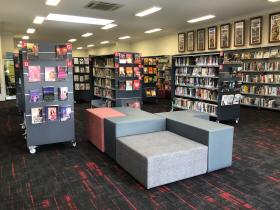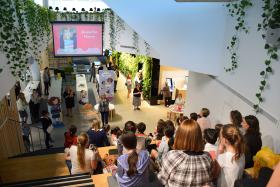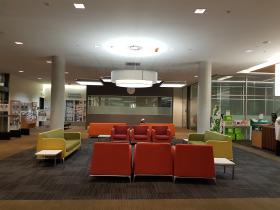Features and considerations: Flexible and multifunctional buildings
Layout and service requirements change so rapidly that flexibility must be designed and built into a new library building.
In assessing the needs and service provision for a community, factors such as population growth, demographic changes and service delivery may result in additional space requirements or provision for expansion that must be accommodated as part of the conceptual and building design. It is not possible to predict all future needs but an approach to the design that allows flexibility and adaptability will allow for easier modifications to the function of the library space.
- structural layouts which allow for non load-bearing walls or demountable partitions, that can be removed or relocated with minimal disruption to the building
- lighting choice and positioning to allow flexibility for the relocation of shelving systems and furniture
- a reticulated layout of mechanical and electrical services to accommodate changes as required. Modular ceilings and ceiling tracks will allow for changes to layouts of air-conditioning grilles, light fittings and power. Some allow for easy suspension of flexible cabling and power to furniture locations. Skirting, floor boxes (designed to avoid trip hazards) and raised flooring systems allow levels of flexibility for power and data cabling. Some features such as skirting or chair rail height panels can be used to retrofit power and cabling to older buildings.
When planning for future extensions it is important to identify specific locations as part of the design process. If possible, allowance should be made for sufficient space on site for the construction of a later stage and if potentially building upward, the structure should be designed to accommodate the extra loading.
Flexible interiors

Most libraries experience fluctuating demand for space. This can occur at different times of the day, for example the after-school influx of children, different days of the week or at different times of the year, for example pre-HSC, or holiday periods with school holiday programs or a large number of tourists. This can make it difficult to plan a suitable sized library. Flexible use of space may be required to manage these changes in demand – meeting rooms that can be opened up for additional reading or Wi-Fi use, and furniture and shelving that can be moved and/or serve a number of functions.
Many libraries find that there are an increasing number of groups wanting to use the library spaces during the evening when the library is closed. Libraries may want to consider after-hours access without staff, exploring technology options to assist in making library facilities available safely.
A flexible interior fitout allows a library to accommodate fluctuations in user numbers day to day, allowing a greater variety of activities. In the longer term, changes in collections and use, as well as significant functional changes should be easily achieved without significant impact upon the building.
Flexible interiors are characterised by:
- flexible space dividers: elements that facilitate changes in room size e.g. operable walls, folding doors, sliding doors, curtains
- flexible infrastructure: elements that allow services (lighting, ventilation, heating, cooling, power, data) to be reconfigured and accessed from any point in the building. This is relevant to both day to day control and ongoing maintenance, e.g. zoned air conditioning systems or lighting which can be controlled centrally and locally; Wi-Fi which allows access throughout the library; power which can be accessed in the centre of the library as well as the perimeter
- flexible furniture and finishes: elements that can be easily moved, reused or stored away, or are multi-purpose e.g. shelving units on wheels, or furniture which can either be seating or a table
- flexible access: allowing out of hours events and out of hours access
- flexible approach: to inhabiting the space, outside areas available for different uses
- loose joinery pieces: flexible display for posters, books and other items, play equipment, seating benches
- privacy screens: curtains, screens
- changeable display surfaces: pinboard, whiteboard/write-on glass, magnetic walls, slatwall, digital display
- variety of loose seating options: sofas, chairs, bean bags, stools, armchairs, task chairs, floor cushions
- variety of tables, preferably folding or on wheels: single and communal study tables, modular meeting room tables, small laptop tables, coffee tables, small side tables (which can double as stools)
- changeable floor surfaces: rugs, carpet squares, padded surfaces for kids play areas, waterproof mats, crash mats
- all-purpose built-in joinery along perimeter walls: seating, benchtops, wall shelves.
Activity and meeting rooms
Meeting rooms in libraries have often been separated from the rest of the library. This may allow for after hour access but can mean that there is no connection between the rooms and other library spaces. If designed for a specific purpose a room can end up unused for a lot of the day. To fulfil their potential, activity and meeting rooms can be planned for multifunction and flexible use, designed as spaces that change for the cycle of use across the day.
Rooms within the library can be constructed with glass walls that fold or stack to open up the space to become part of the library when not in use. Glass walls make the activity visible from other areas of the library. This can promote activities to other users of the library and create a sense of connection. ‘Hold open’ doors are another option to make it obvious that the rooms are available when not used for programs.
These rooms need to be acoustically separate with acoustic treatment in ceilings and/or walls. Glass panels are available with different levels of acoustic rating. Glass walled rooms can be built with blinds or shades that drop from the ceiling for privacy or for screening movies and presentations. Power and technology access can also drop from the ceiling to enable flexible use of the space. If used more broadly this feature can be used to increase flexibility throughout the library space.
Rooms can include smaller breakout areas within them for example in pods or booths. These are suitable as breakout spaces during meetings or workshops and as general workspaces when the room is not in use for a specific event. Rooms should include technology and facilities to allow hybrid delivery of events to onsite and offsite users at the same time.
If you don’t have the capacity to build new flexible meeting rooms within your library the purchase of movable furniture, such as stacking chairs, flip tables and modular furniture can significantly increase the flexibility of existing rooms. Storage within the rooms or nearby will be required.
Multifunctional buildings
As a community meeting space and cultural hub, a public library offers a range of spaces beyond traditional library services. While frequently the flexibility of the core library space will allow many events to occur by simply moving furniture, library briefs are expanding to accommodate a range of additional spaces including additional meeting spaces, multipurpose halls, workshops, performance areas and exhibition space. These spaces are highly popular with community groups as well as organisations and individuals keen to hire the space for classes, book launches, performances and exhibitions.

Issues to consider should include:
- spaces which accommodate a range of activities
- storage of furniture and possible storage for community group resources
- flexibility to subdivide space
- acoustics and impact on main library space
- out-of-hours access
- food catering or kitchenette facilities
- flooring that will accommodate a range of needs
- consideration of whether basic rigging, theatrical equipment, exhibition and display may be appropriate.
External space should also be considered as a multifunctional space allowing for activities such as outdoor performances, markets and functions.
A multifunction library building can comprise a library with additional workshop, meeting and performance spaces, as mentioned above. However, a larger multifunction building is likely to include a number of different services and spaces that require extra planning and consideration.
Large multifunctional buildings
Planning a library service within a large multifunctional building requires consideration of similar issues as planning a co-located library. Policy development, management, resourcing, staffing and space allocation need to be carefully planned with relevant stakeholders. Services could be provided by the library and operated by the same management team with staff diversifying their roles to cover a range of services. In contrast library services could be provided by library staff with other services provided by non-library staff. The management team could consist of separate managers for each service or could be provided by a combined library and community services (or similar) role.

When planning the spaces and location of services it is crucial to consider the way users will interact with the space and move from one space to another. The multifunctional complex will attract members of the community who were not planning to visit the library. This provides an opportunity to entice them into the library space and show them what is on offer, with the added advantage of potential new library members. Serendipitous discovery of different activities, spaces and collections can occur.
Services to be offered within the building should respond to local community needs and provide the opportunity for locally based organisations to strengthen their connections with the community. Partnerships between the library and local services become easier to develop because relevant groups are already working within the same location. The combination of services and spaces will attract a broader spread of the community and increase council’s ability to assist social cohesion and cross-cultural understanding.
Because of the substantial size, additional services and increased budget a large multifunctional library creates more of an opportunity for the development of an iconic building with aspirational architecture. This serves to regenerate the location, drawing more visitors to the area who activate surrounding streets and spaces through visits to shops and other nearby facilities.
The planning of the internal layout will need to consider use over different opening hours, and access to different parts of the building at different times of the day. The building might include large spaces that are not used regularly, staff can provide input on how to make best use of these spaces.
Depending on the design, acoustic treatment may be even more important than in a more traditional library. Contemporary buildings often include large open foyers, voids and mezzanine spaces that if left untreated can enable noise transfer to an extent that makes the spaces unusable. Quiet spaces with less sensory stimulation may be required.
Wayfinding and signage are extremely important in large buildings that offer a range of services to allow people to move easily through the building and find the spaces they want to access. Consideration of staff spaces and how staff from different areas interact and move from public to back of house areas and tasks is also crucial.
Related content
- Table of contents
- Features and considerations
- Service areas
- Planning
- Community needs
- Starting your library project: working group
- New building, refurbishment or mobile?
- Co-location and joint use libraries
- Developing a building brief
- Understanding the building design and construction phases
- Selecting the architect, project manager and other consultants
- Funding and costs
- Staffing requirements
- Collection plan
- Developing a local technology plan
- Workplace health and safety: risk and opportunity in design
- Evaluation: post construction and post occupancy
- Planning tools
- Influence
- Reading and references
Enter a search term in the box above